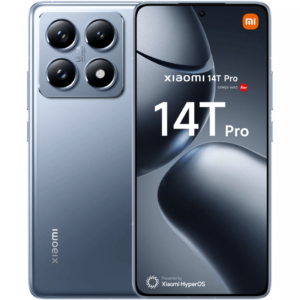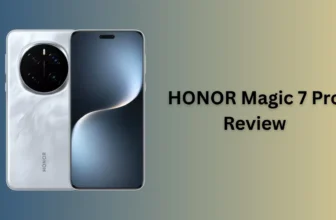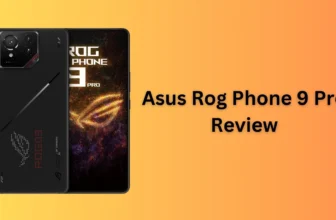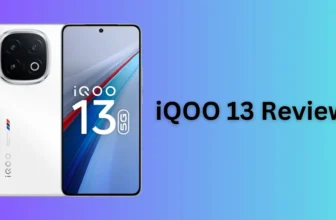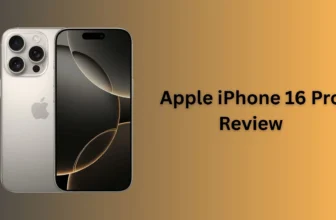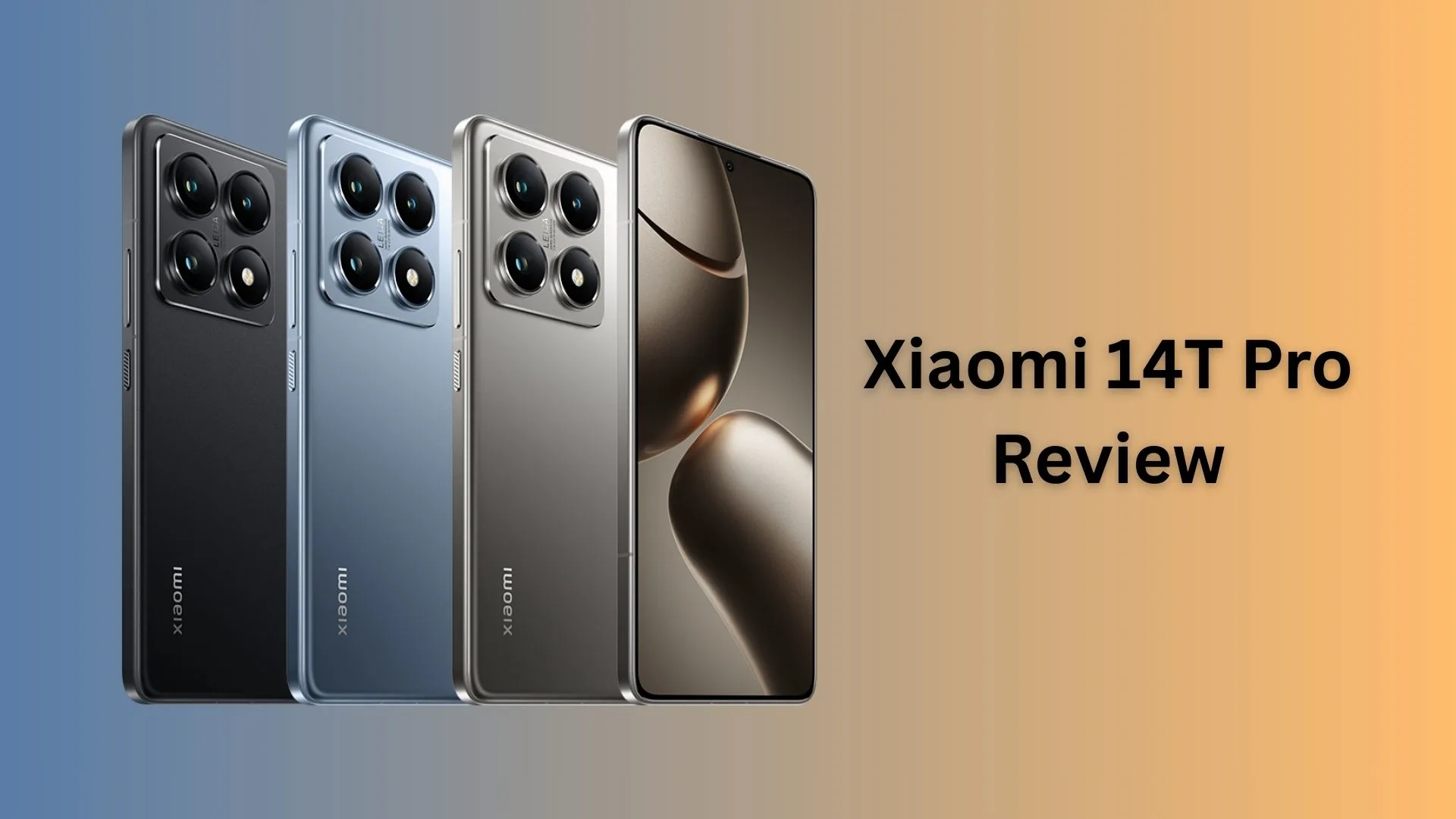
The Xiaomi 14T Pro lands exactly one year after its predecessor, and right away you’ll notice a few key changes. Inside the box you’ll find the phone, a black rubber protective case, and a USB-C cable—Apple-style power adapter no longer included. This phone is not released in India but starting price is around Rs. 75,000 in globally, roughly Rs. 5,000 higher than last year. Xiaomi has also phased out the 8 GB RAM option, so every 14T Pro ships with 12GB paired with either 256GB, 512GB, or 1TB of storage. This price bump feels justified by the host of upgrades we’re about to explore.
Design and Build
Xiaomi now offers the 14T Pro in Titan Black, Titan Blue, and Titan Grey. While the colour names nod to titanium, the side rails are actually high-strength aluminium—a significant step up from the plastic frames used on the 13T Pro. The chassis is thinner overall, with flat matte rails that wrap uniformly around the phone.
The power button sports a subtle textured finish for easier reach without looking. Corners are gently rounded—less bulbous than recent Pixels and iPhones—giving you a solid, premium feel in hand. Subtle edge curves balance comfort and grip, evoking flagship quality.
The camera island now matches the glass back’s hue, echoing the rest of the Xiaomi 14 lineup. Xiaomi hasn’t specified the rear glass type, but the front remains protected by Gorilla Glass 5. I would have preferred Gorilla Glass Victus for extra peace of mind.
Despite sticking with IP68 water resistance, Xiaomi broadens its safety margin: you can now submerge the phone up to 2 metres for 30 minutes, versus the usual 1.5 metres. The optical fingerprint scanner lives under the display, and the bezels are impressively slim—the bottom chin almost matches the side and top borders.
Display
At a glance the 6.67-inch AMOLED panel looks unchanged: Full HD+ resolution, 144Hz refresh rate, and still no LTPO technology. Under the hood, however, Xiaomi upgrades to a C8 Plus panel material. Touch sampling soars to a blazing 2160Hz, while PWM dimming jumps to 3840Hz for reduced eye fatigue. High brightness mode reaches 1,600 nits, and peak brightness hits an astounding 4,000 nits—surpassing even the Xiaomi 14 Ultra.
Software
The 14T Pro debuts HyperOS atop Android 14, replacing last year’s MIUI 14. HyperOS already feels smoother and more responsive with continued use. Google apps come preinstalled, and Xiaomi’s deeper collaboration with Google brings Gemini AI onboard right out of the box. More AI-driven features—like Circle to Search—are on the road map. Xiaomi promises four years of major OS upgrades and five years of security patches.
Battery and Charging
Battery capacity remains at 5000 mAh, and wired charging still clocks in at 120W for blistering refill times. The real headline this cycle is wireless charging: for the first time on a T-series flagship, you get 50 W wireless top-ups. That change alone will thrill series loyalists.
Hardware and Performance
Memory and storage hardware stick with LPDDR5X RAM and UFS 4.0 flash, but Xiaomi now tacks on extra “memory extension” based on your storage tier—8GB more RAM for the 256GB model, 16GB for the 512GB, and 32GB for the 1TB version. Under the hood sits MediaTek’s new Dimensity 9300 Plus. Like the base 9300, it forgoes efficiency cores in favour of four performance cores, one of which is bumped to 3.4 GHz here.
In real-world use, the 9300 Plus delivers performance on par with Snapdragon 8 Gen 3 while offering slightly better energy efficiency. Xiaomi’s new 3D Ice Loop cooling system also keeps temperatures in check during gaming marathons. Connectivity features mirror the previous model—Bluetooth 5.4, NFC, Wi-Fi 7, dual 5G, IR blaster—and the USB-C port remains at USB 2.0 speeds. Haptics have been refined to feel closer to the 14 Ultra’s, and dual-speaker output stays loud and clear.
Xiaomi 14T Pro
₹49,999.00- Display: 6.67″ AMOLED (1.5K)
- Chipset: MediaTek Dimensity 9300+
- Memory: 12GB RAM, 1TB Storage
- OS: …
| GENERAL | ||||||||||||||||||||
|---|---|---|---|---|---|---|---|---|---|---|---|---|---|---|---|---|---|---|---|---|
| ||||||||||||||||||||
| BODY | ||||||||||||||||||||
| ||||||||||||||||||||
| DISPLAY | ||||||||||||||||||||
| ||||||||||||||||||||
| PERFORMANCE | ||||||||||||||||||||
| ||||||||||||||||||||
| MEMORY | ||||||||||||||||||||
| ||||||||||||||||||||
| SOFTWARE | ||||||||||||||||||||
| ||||||||||||||||||||
| REAR CAMERA | ||||||||||||||||||||
| ||||||||||||||||||||
| FRONT CAMERA | ||||||||||||||||||||
| ||||||||||||||||||||
| BATTERY | ||||||||||||||||||||
| ||||||||||||||||||||
| NETWORK | ||||||||||||||||||||
| ||||||||||||||||||||
| CONNECTIVITY | ||||||||||||||||||||
| ||||||||||||||||||||
| MULTIMEDIA | ||||||||||||||||||||
| ||||||||||||||||||||
| SENSORS | ||||||||||||||||||||
| ||||||||||||||||||||
| AnTuTu Scores | ||||||||||||||||||||
| ||||||||||||||||||||
| Geekbench Scores | ||||||||||||||||||||
| ||||||||||||||||||||
Cameras
The front-facing shooter jumps to a 32 MP sensor, delivering sharper selfies and more precise edge detection despite a slightly narrower field of view. Low-light shots improve noticeably when you tap the display flash, and you can now film yourself in 4K at 30 FPS—a significant leap from the previous model’s 1080p cap. Full-HD recording at 60 FPS remains available, though wind noise can affect the built-in mic on blustery days. Bokeh-style video is still limited to 1080p, but night-time selfie clips look a bit cleaner than before.
Xiaomi’s continued partnership with Leica brings over new shooting presets from the Ultra series. Vibrance delivers punchy, saturated tones, while Authentic favours more natural hues. Portrait photographers gain two distinct looks: Leica Portrait for moody, DSLR-style renders and Master Portrait for brighter, evenly lit results. The new Master Cinema mode records 10-bit Rec. 2020 footage, and HDR10+ video is supported on the main camera—though the background blur effect remains 1080p only.
The primary rear camera is identical to the Xiaomi 14’s Light Fusion 900 setup: a 50 MP 1/1.31-inch sensor with an f/1.6 lens. You can capture full-resolution images or rely on pixel binning for balanced 12.5 MP shots that hold detail even at 2× zoom. Nighttime snaps benefit from the wider aperture, though low-light noise reduction could still be refined. Slow-motion at up to 960 FPS stays exclusive to this main sensor, and while “Steady Video” crops into 1080p, 4K 60 FPS footage is rock-steady—even extending to 8K recording after the crop. Shooting 8K in the dark yields finer detail with less grain, whereas 4K night mode brightens scenes at the expense of some sharpness.
The telephoto lens also receives a bump: it’s now a 50 MP, 1/2.76-inch ISOCELL JN1 sensor with an f/1.9 aperture and 2.6× optical reach. OIS-assisted snaps look cleaner at 5×, and you can push the digital zoom up to 30×—a notable improvement over last year’s 20× cap. Low-light performance is impressive up to 5×, with decent results even at the extreme end. Video tops out at 4K 60 FPS, offering smooth footage in daylight, though night recording introduces more noise and slightly less stabilization.
Xiaomi keeps the 12 MP ultra-wide module unchanged, complete with a 120° field of view. Daytime panoramas remain sharp and colour-accurate, but after sundown the sensor struggles with fine details and noise. Its steady-video option still crops into 1080p at 30 FPS—while 60 FPS is available in standard video mode—and 4K clips are capped at 30 FPS, delivering underwhelming nighttime performance.
Final thought
Xiaomi’s 14T Pro builds on its predecessor with metal side rails, improved waterproofing, slimmer bezels, a brighter display, and the welcome addition of 50 W wireless charging. The camera system sees its most substantial refresh yet, from a higher-resolution selfie camera to upgraded main and telephoto sensors with Leica-tuned modes and enhanced video capabilities.
Missing an LTPO display, charging brick in the box, USB 3.0 speeds, and a more advanced ultra-wide camera may disappoint some, but those trade-offs keep the price competitive. By balancing premium refinements against cost-saving decisions, Xiaomi has crafted a T-series flagship that hits its target: top-tier features without the top-tier price tag.
